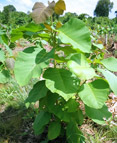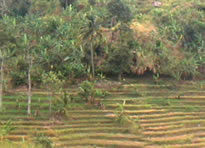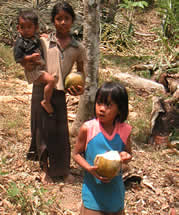Our extraction methods will be designed to have the minimum impact.
 Natural teak takes 50 to 60 years to grow to maturity and yield the highest quality wood, making it a valuable and increasingly scarce resource.
Natural teak takes 50 to 60 years to grow to maturity and yield the highest quality wood, making it a valuable and increasingly scarce resource.
However, recent research has shown that it is possible to use new techniques to allow teak trees to reach this maturity in a much shorter time frame of 20-25 years. This new variant is known as ‘golden teak’.
GoldTeak has created a Pilot project in association with the Indonesian Company PT. Soegih Mas Agro. This company, headed by Dr. Soegiharto, has applied modern cloning techniques to produce a teak seedling that grows significantly faster than those trees produced through the traditional seed mechanism.
The teak tree shown above is growing in Thailand and is estimated to be 20 years old. The existence of a variant of teak that grows faster than the traditional tree has probably been known for 7 years.
The Pilot Project, located in Sukabumi, south of Bogor, extends to about 20 hectares with an initial planting density of 1100 trees per hectare. Situated in very fertile land south of the Indonesian capital Jakarta, this project aims to demonstrate how a properly managed teak plantation can derive significant financial return for the investors, and at the same time balance the management of the plantation with careful concern for the local villagers, who through innovative incentive schemes will derive a financial benefit themselves through the project.
The wholescale plantation of a single variety of tree could have significant detrimental effects on a local community. If the land was completely cleared and the trees planted, this would displace the local people from their areas and possibly even their livelihoods.
By planting the teak trees in carefully chosen locations on unused land, the local people can be incorporated as stakeholders in the project, rather than alienating them with the inherent consequent risks that might be incurred.
The picture (below) shows a view of the area chosen for the pilot scheme. The lower land is used for subsistence agriculture such as rice paddy fields, but it is estimated that some 80% of the land in the region is lying unused and is very suitable for growing teak, especially on the high ground.
Teak Management Strategy
 The rate of growth and the quality of teak from plantations are largely dependent on the type and quality of the seedlings; the physical and chemical characteristics of the soil, including topography and drainage; rainfall, temperature, humidity; and on the management techniques employed. The management objective must be to grow the trees to meet target quality criteria in a non-destructive manner. From a purely financial perspective, the number one quality criteria will be the log diameter, followed by the density of the wood, its colour and its shelf life. This will put the wood at the high price end of the spectrum at harvest time.
The rate of growth and the quality of teak from plantations are largely dependent on the type and quality of the seedlings; the physical and chemical characteristics of the soil, including topography and drainage; rainfall, temperature, humidity; and on the management techniques employed. The management objective must be to grow the trees to meet target quality criteria in a non-destructive manner. From a purely financial perspective, the number one quality criteria will be the log diameter, followed by the density of the wood, its colour and its shelf life. This will put the wood at the high price end of the spectrum at harvest time.
The price of teak varies widely dependent on these quality considerations. In Indonesia, the teak is broadly classified into three groups, with Grade A being the best quality available and usually only derived from the oldest mature trees.
The clearance of the land prior to planting of the seedlings must be done in such a way as to ensure the minimum impact on the local community and to reduce the risk of soil erosion. Rainfall can be very heavy in Indonesia, and exposed soil in hilly terrain is at serious risk of being washed away if there are insufficient root structures to prevent this.
With this in mind, only brushwood and smaller trees such as the banana have been cleared away on the Pilot Project at the outset. Larger mature trees have been left standing where possible in order to bind the soil together and help protect the teak seedlings against heavy rainfall and other climatic conditions. Instead of completely clearing the land, which would be the most efficient way of allowing the planting of the seedlings to progress, these trees that remain permit the change to the landscape to be less brutal than might otherwise be the case, reducing the impact on the local villagers.
The initial planting density of the teak seedlings has been chosen to be 1100 per hectare. This equates to a spacing of about 2.5 metres between each seedling. An initial fertilisation enables them to get the best start in life. In addition, the planting is done so as to ensure good aeration of the root systems.
The teak seedlings will be at their most vulnerable during the first few years of growth. Since each has typically cost about $1 – $ 2 dollars at planting, the investment is already significant and each seedling will need constant attention to prevent overgrowth by other vigorous plants, and damage through water, fire, or even theft.
With this in mind, the Pilot Project has developed an unique solution to involve local people and integrate them completely in the success of the project.
This unique solution is two fold. The first part involves the planting of vegetables between the rows of trees. The implements and seeds to enable this have been supplied by GoldTeak in order to maximise the chances of success.
The local villagers in the vicinity of the Pilot Project land survive typically with subsistence farming. The large areas of unused land provide an abundance of fruit and other foods, and flat areas are typically turned into paddy fields for rice or other fields to support the growing of crops.
By allowing the land between the trees to be used for vegetable and other crops there are many benefits both to the local villagers and the teak investors.
The local villagers can easily produce sufficient food for their own needs and have also the ability to sell the excess produce on the market to generate an income for some of the basic necessities in life that many have been deprived of. The income generated by these market sales will be shared with the GoldTeak plantation manager, who will, thereby, be able to recoup for GoldTeak the initial cost of providing the farm implements and seed.
Several local villagers will join the scheme, and their progress will be reported regularly through this website.
Allow us to introduce Aan and his family. (His children are shown here).
 Before the Pilot Scheme was started Aan and his family lived in a small shack next to the land acquired by GoldTeak and survived through farming a strip of paddy field and harvesting the bananas, pineapples, coconuts and other foods that grew wild in the vicinity. They had, essentially, nothing. The children were dressed in poor clothes and had few prospects.
Before the Pilot Scheme was started Aan and his family lived in a small shack next to the land acquired by GoldTeak and survived through farming a strip of paddy field and harvesting the bananas, pineapples, coconuts and other foods that grew wild in the vicinity. They had, essentially, nothing. The children were dressed in poor clothes and had few prospects.
The planting of vegetables and other crops on the Pilot Scheme will have other benefits. Planting up the land will help to prevent the deterioration of the soil in a mono-culture and the loss of the soil through erosion. Care is taken to ensure that those vegetables and crops planted provide the maximum benefit by the fixing of nitrogen into the soil. This will be important in the years to follow, especially after canopy closure, which might be expected to start after 3 to 4 years and before the trees are thinned. A suitable under-storey of vegetation can also reduce attack by defoliators, so once crop planting is restricted by lack of light through the canopy, the natural forest bush can take over, and other crops more suitable for this environment will be planted.
After a period of about 5 years, some trees will be cut to reduce the planting density and allow those remaining to grow towards maturity. The local villagers will be involved in this thinning, and will benefit directly from it.
This second and very important part of the unique GoldTeak solution involves the payment of a cash bonus for each healthy, good quality tree per year. There is to be an extra bonus for the trees reaching maturity is an innovative ‘pension’ scheme. This payment scheme will ensure that the locals are diligent against the evils of tree theft, tree diseases and fires. This incentive is also something that we hope will be strongly favoured by local government and regional government.
| GoldTeak plantation incentive scheme for guarding and tending trees | ||||
| Number of trees | Bonus per tree per year | Number of years | Subtotal (maximums) | |
| Up to first felling at year 7 | 1100 max | US$0.25 | 7 | US$1,925 |
| Up to final felling at year 25 | 500 max | US$0.25 | 18 | US$2,250 |
| Upon final felling at year 25 | 500 max | US$2.00 | – | US$1,000 |
| Total: | US$5,175 | |||
As the teak trees approach maturity, there will be temptations to be involved with illegal logging activities. Since each hectare or similar size of plantation is guarded by an individual villager and his family, any activity in a part of the Pilot Project, would be quickly reported to the plantation management.
GoldTeak hope to change the lives of Aan and his children, and the other villagers who are involved in the scheme for the better. This is our committed aim and our promise. Through becoming involved with similar projects you can help to change others? lives, even if you never meet them.
 The initial spacing between saplings, the timing and intensity of thinning, and replanting determines the space made available to each tree and this has a big influence on the quality of the timber and the production performance. The fewer trees in the stand then the bigger the bole, but the thinning and pruning regime is necessary to encourage the wood to build in the stem rather than in the canopy. Our programme is built from experience gained, and timed by the dominant height. The dominant height measurement is the average height of the 100 largest diameter trees per hectare.
The initial spacing between saplings, the timing and intensity of thinning, and replanting determines the space made available to each tree and this has a big influence on the quality of the timber and the production performance. The fewer trees in the stand then the bigger the bole, but the thinning and pruning regime is necessary to encourage the wood to build in the stem rather than in the canopy. Our programme is built from experience gained, and timed by the dominant height. The dominant height measurement is the average height of the 100 largest diameter trees per hectare.
Thinning obviously produces timber which can be sold. Depending on the quality of the wood this may be sold for industrial and furniture grade or for paper pulping. The latter would reduce the pressure on mature teak being used for this purpose which is currently a major driving force in the illegal logging of the natural forest in Indonesia. The total capacity of the wood-processing industry and the pulp and paper processing industry is 80 million cubic metres. Legal logging produces 17 million cubic metres.
The thinning also creates space for planting of the next generation of saplings, indeed, the tree stumps often shoot themselves and the new tree provides further revenue in about 15 years time.
Our extraction methods will be designed to have the minimum impact on the ecology that would be established in the plantation. Local companies would be commissioned to perform the felling and log cutting. This will promote jobs in the area.
Lastly, it is not just the survival of trees to maturity that is sufficient to ensure profit ? the marketing is also essential.